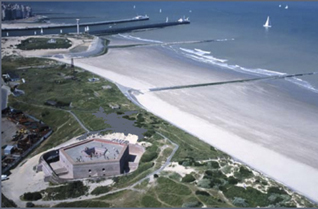Successful Fifth Edition of the Annual Ename International Colloquium
 The fifth edition of the Annual Ename International Colloquium took place from the 18th to the 20th of March 2009. The theme was “Climates of Heritage Conservation”. For the first time the colloquium was held at two locations: Ghent and Ostend. Specialists from all over the world met to discuss the consequences of climate change for heritage care with a focus on Public Engagement and Social Innovation. The rising sea level and the expected increase in floods received special attention, and the vulnerability of the Low Countries due to the consequences of climate change formed the starting point.
The fifth edition of the Annual Ename International Colloquium took place from the 18th to the 20th of March 2009. The theme was “Climates of Heritage Conservation”. For the first time the colloquium was held at two locations: Ghent and Ostend. Specialists from all over the world met to discuss the consequences of climate change for heritage care with a focus on Public Engagement and Social Innovation. The rising sea level and the expected increase in floods received special attention, and the vulnerability of the Low Countries due to the consequences of climate change formed the starting point.
Although the theme of climate change has featured on the political agenda for some twenty years now, the explicit attention from the heritage world is fairly recent. This is remarkable because cultural heritage is often incorporated within the most vulnerable structures of our patrimony and is extra sensitive to climate changes. Moreover, these changes often have direct or indirect consequences for the way of life and the immaterial heritage of cultural communities. Not surprisingly, one of the most important conclusions of the colloquium was that heritage care can create substantial public support for more awareness of the direct influence that climate change has on our environment.
The organizers could count on May Cassar from the Centre for Sustainable Heritage, University College London, as the keynote speaker for the thematic opening of the colloquium. Thanks to the unremitting efforts of Pamela Jerome climate change has become a longstanding point of interest within ICOMOS. Therefore, we were very happy that the colloquium could count on the collaboration of the ICOMOS Global Climate Change Task Force. The World Monuments Fund offered special support. Michelle Berenfeld could refer to the many examples of cultural sites that feature on the list of the 100 most threatened sites in the world as a consequence of climate change. However, the colloquium would never have been possible in the first place without the support and the contribution of Diane Barthel-Bouchier of Stony Brook University, NY, who focused on the social dimension of the theme.
 Apart from Stony Brook University, the colloquium was also made possible by the organisational support of the Province of East Flanders, the Flemish Heritage Institute and the Flemish Marine Institute. This made certain that the consequences of climate change for the Low Countries received substantial attention. The double location in Ghent and Ostend also enabled the organizers to present two widely divergent case studies: the precarious equilibrium in the water balance within the historical city centre of Ghent since the Middle Ages and the impact of the sea on the various forms of heritage along the Belgian coastline. The colloquium was rounded off with a dinner in a suitably relevant location: Fort Napoleon, a French fortification that was built in the dunes of Ostend at the beginning of the 19th century. Throughout the three days, parallel workshops with presentations from different parts of the world made this edition of the colloquium once more truly meaningful and fruitful.
Apart from Stony Brook University, the colloquium was also made possible by the organisational support of the Province of East Flanders, the Flemish Heritage Institute and the Flemish Marine Institute. This made certain that the consequences of climate change for the Low Countries received substantial attention. The double location in Ghent and Ostend also enabled the organizers to present two widely divergent case studies: the precarious equilibrium in the water balance within the historical city centre of Ghent since the Middle Ages and the impact of the sea on the various forms of heritage along the Belgian coastline. The colloquium was rounded off with a dinner in a suitably relevant location: Fort Napoleon, a French fortification that was built in the dunes of Ostend at the beginning of the 19th century. Throughout the three days, parallel workshops with presentations from different parts of the world made this edition of the colloquium once more truly meaningful and fruitful.
co-organised by:
The Province of East-Flanders
The Flanders Marine Institute
The Flemish Heritage Institute
Stony Brook University, NY
The Ename Center for Public Archaeology and Heritage Presentation
co-sponsored by:
The World Monuments Fund
with the collaboration of:
ICOMOS Global Climate Change Task Force.

Back to newsletter
Pictures
